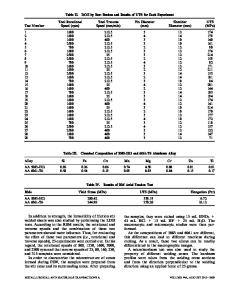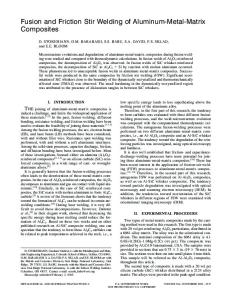Improving Joint Formation and Tensile Properties of Dissimilar Friction Stir Welding of Aluminum and Magnesium Alloys by
- PDF / 2,882,759 Bytes
- 10 Pages / 593.972 x 792 pts Page_size
- 89 Downloads / 331 Views
JMEPEG https://doi.org/10.1007/s11665-018-3216-y
Improving Joint Formation and Tensile Properties of Dissimilar Friction Stir Welding of Aluminum and Magnesium Alloys by Solving the Pin Adhesion Problem Zhenlei Liu, Shude Ji, and Xiangchen Meng (Submitted June 22, 2017; in revised form December 25, 2017) Friction stir welding (FSW), as a solid-state welding technology invented by TWI in 1991, has potential to join dissimilar Al/Mg alloys. In this study, the pin adhesion phenomenon affecting joint quality during FSW of 6061-T6 aluminum and AZ31B magnesium alloys was investigated. The adhesion phenomenon induced by higher heat input easily transformed the tapered-and-screwed pin into a tapered pin, which greatly reduced the toolÕs ability to drive the plasticized materials and further deteriorated joint formation. Under the condition without the pin adhesion, the complex intercalated interlayer at the bottom of stir zone was beneficial to mechanical interlocking of Al/Mg alloys, improving tensile properties. However, the formation of intermetallic compounds was still the main reason of the joint fracture, significantly deteriorating tensile properties. Under the welding speed of 60 mm/min without the pin adhesion phenomenon, the maximum tensile strength of 107 MPa and elongation of 1.2% were achieved. Keywords
aluminum and magnesium alloys, friction stir welding, intermetallic compounds, pin adhesion, tensile properties
1. Introduction Al alloys own high specific strength and excellent corrosion resistance, while Mg alloys, as the structural metal with the lowest density, possess high specific strength and rigidity as well as good damping capacity (Ref 1). In the background of energy saving and emission reduction for the industries of highspeed train, aerospace and ship, optimizing structural configuration and decreasing design weight are inevitable. The welding problems of the dissimilar Al/Mg alloys have become a research hot spot. Because of the coarse grains, hot cracks, pores and amounts of brittle intermetallic compounds (IMCs), conventional fusion welding techniques are difficult to obtain the high-quality Al/Mg joint (Ref 2-4). Friction stir welding (FSW), involving temperature, mechanics, metallurgy and interactions, has been a potential candidate to join dissimilar Al/Mg alloys. Up to now, most investigations about the dissimilar FSW of Al/Mg alloys have been conducted, which mainly concentrated on effects of the IMCs on joint formation and mechanical properties. Xu et al.
Zhenlei Liu and Shude Ji, Faculty of Aerospace Engineering, Shenyang Aerospace University, Shenyang 110136, Peoples Republic of China; and Xiangchen Meng, Faculty of Aerospace Engineering, Shenyang Aerospace University, Shenyang 110136, PeopleÕs Republic of China; and State Key Laboratory of Advanced Welding and Joining, Harbin Institute of Technology, Harbin 150001, PeopleÕs Republic of China. Contact e-mails: [email protected] and [email protected].
Journal of Materials Engineering and Performance
(Ref 4) expounded that welding temperat
Data Loading...











